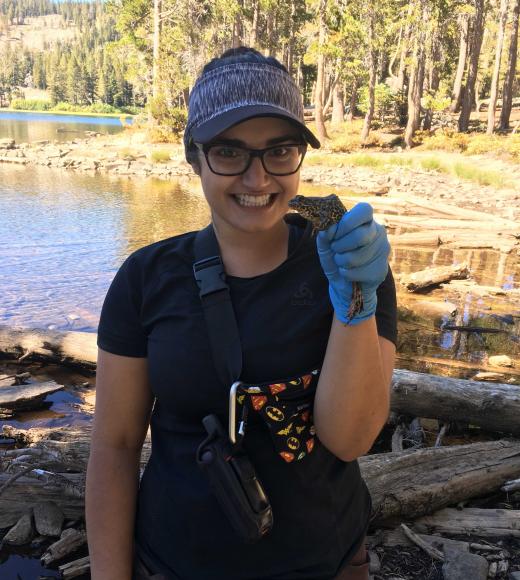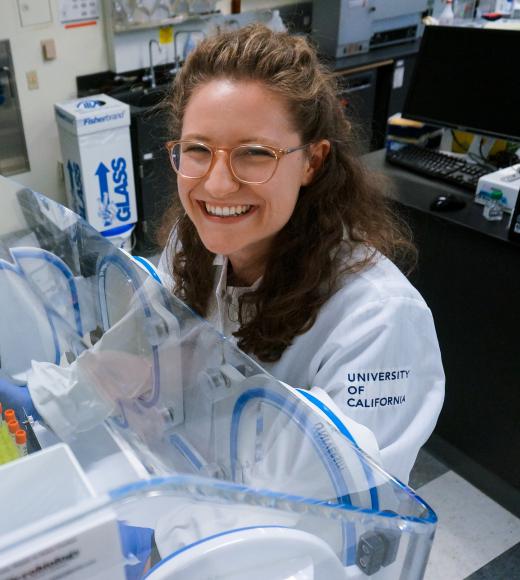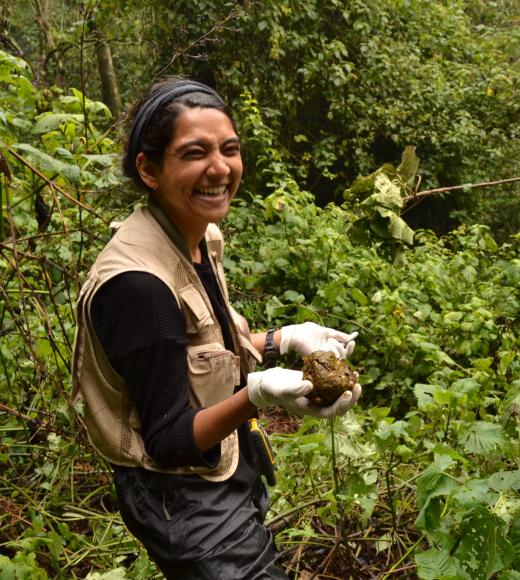Awarded Projects - 2019
15 research projects were selected from a total of 36 applications covering a wide variety of disciplines:
 Microbial Ecology of Wild and Domesticated Chickpeas
Microbial Ecology of Wild and Domesticated Chickpeas
By: Betsy Alford, Department of Plant Pathology
Cereals and pulses such as barley, wheat, chickpea, pea and lentil were among the first crops to be domesticated 10,000-13,000 years ago in the Fertile Crescent. As wild plants transitioned to domesticated crops, plants were selected for a limited number of traits and for performance in systems characterized by inputs and crop management. Compared to their wild relatives, domesticated plants exhibit reduced sensitivity to temperature fluctuations and photoperiod, often increasing planting range. Many domesticated crops possess modified root systems, leading to reduced foraging and nutrient uptake. The transition from dynamic wild systems to modern high input monoculture has been implicated in reduced ability of domesticated plants to recruit and respond to microbial interactions. We examine this transition from wild, areas of long-standing cultivation, to areas of recent introduction with amplicon analysis of wild chickpea plants from Turkey, cultivated plants from Ethiopia, India, Canada, and the United States.
 Drivers of Periphyton Biomass in Oligotrophic Lakes
Drivers of Periphyton Biomass in Oligotrophic Lakes
By: Karen Atkins, Hydrologic Sciences Graduate Group
Periphyton, microbial algae attached to the boundaries of freshwater environments, plays important ecological roles as the base of many aquatic food webs and as indicator species of water quality. The periphyton biomass at a particular location is dependent on a range of physical, chemical, and biological variables. These influences on periphyton cause high spatial and temporal variability in biomass and make its management challenging. My research aims to explain drivers of periphyton biomass in Sierra Nevada lakes.
After analyzing over 30 years of periphyton data in Lake Tahoe, it is apparent that community dynamics are a crucial component to understanding periphyton biomass trends. Therefore, I began monthly monitoring of periphyton taxonomy. I will use the taxonomic data to inform a periphyton biomass model. My periphyton model accounts for fluxes of temperature, light, water level, nutrients, sloughing, and grazing. The model will contribute to the understanding of periphyton drivers and management.

In vitro characterization of Lactobacillus spp. enriched during consumption of diets enriched in whole grains
By: Zachary Bendiks, Department of Food Science and Technology
Whole grain (WG) foods contain complex mixtures of fermentable carbohydrates that are metabolized by the gut microbiota to support human health. However, little is known about the precise molecular WG-gut microbiota interactions, including the primary, bacterial WG degraders and their carbohydrate utilization preferences. Previously, I observed a selective enrichment of Lactobacillus spp. in the cecal microbiota of rats fed WG maize using 16S rRNA metataxonomics, and used selective media to isolate Lactobacillus from those cecal contents. In this project, I will investigate the capacity of these Lactobacillus isolates to metabolize individual components of WG. This study will provide novel insight into host-adapted lactobacilli and the contributions of individual members of the gut microbiome toward the metabolism of important dietary constituents.
 Enhancing our understanding of the dark matter fungi associated with the seagrass Zostera marina
Enhancing our understanding of the dark matter fungi associated with the seagrass Zostera marina
By: Cassandra Ettinger, UC Davis Genome Center
Seagrasses are submerged marine flowering plants that provide essential ecosystem services as foundation species including serving as both habitats and hatcheries, participating in nutrient cycling and protecting the coastline from erosion. Seagrasses are the result of convergent evolution with three lineages in the order Alismatales that separately adapted to the marine environment 70 to 100 million years ago. Although many studies have focused on seagrass ecology, only a limited number have investigated the fungal community associated with seagrasses. Compounding this, not much is known about marine fungi; it is estimated that there are more than 10,000 marine fungi, but only ~550 currently have cultured representatives. Thus, the goal of my project is to survey the taxonomic and functional diversity of seagrass associated fungi and to determine the evolutionary and ecological importance of these associations.
 The skin microbiome of Sierra Nevada yellow-legged frogs: population biology and its role in fungal infections and restoration efforts
The skin microbiome of Sierra Nevada yellow-legged frogs: population biology and its role in fungal infections and restoration efforts
By: Sonia Ghose, Department of Evolution and Ecology
Global amphibian declines have been largely driven by skin infection by the fungal pathogen Batrachochytrium dendrobatidis (Bd). Certain skin-associated microbes inhibit Bd growth, therefore manipulating the microbiome is a possible conservation approach. However, efforts have been hampered by a lack of understanding of microbiome-pathogen-host interactions. My work focuses on the microbiome of endangered Sierra Nevada yellow-legged frogs, Rana sierrae. My study includes (1) frog populations naturally persisting with low levels of Bd infection, (2) frogs reared from egg masses collected at naturally persisting source populations, raised in captivity, and subsequently released at reintroduction sites, and (3) frogs translocated from source populations directly to reintroduction sites. I collected skin swabs from five populations over three field seasons. Using sequence data, I will examine shifts in microbiome structure that occur when animals are released from captivity and infected by Bd in the wild, and correlates of low Bd load within the microbiome.
Identifying Nitrogen Fixing Microbes in the Feces of Cattle
By: Jilann Hagey, Deaprtment of Animal Science
California dairy farms use manure as a fertilizer reducing the need for chemical fertilizers, however, correct management remains important to avoid pollution. Identifying specific microbes involved in the nitrogen cycle in feces of dairy cattle could lead to strategies to mitigate environmental impacts and improve fertilization potential of manure. In the 1970s studies found nitrogen fixing activity in rumen contents in vitro and in vivo although it was estimated to be low. Additionally, in 1948 Toth showed the presence of nitrogen fixing bacteria in feces by culturing fecal bacteria in nitrogen-free media. However, the microbial taxa contributing to nitrogen fixation in cow manure have not been identified. Analysis of metagenomic data from 12 fecal samples from commercial dairy cattle identified putative diazotrophs. This proposal aims to test our bioinformatic predictions by evaluating the nitrogen fixing capacity of these microbes and investigate a hypothesis that has been unanswered for 40 years.
 Augmentation of Oral Immunotherapy with Gut Commensal-derived Microparticles
Augmentation of Oral Immunotherapy with Gut Commensal-derived Microparticles
By: Rian Harriman, Graduate Group in Immunology
Current strategies of oral immunotherapy rarely establish long-term tolerance due to their inability to generate allergen-specific regulatory T cells (Treg) that suppress Th2 function and IgE production. Despite these findings, the concept of allergen-delivery systems that directly induce allergen-specific Treg cells has not been explored. We propose that the microparticles fabricated from Polysaccharide A, a well described tolerogenic molecule derived from the gut commensal Bacteroides fragilis, may be an ideal vehicle for the oral delivery of allergen because they could (i) simultaneously induce tolerogenic dendritic cell differentiation and antigen delivery that drive the proliferation of allergen-specific Treg cells and (ii) protect the allergen as it enters the GI tract. If this approach is successful, the Polysaccharide A-Microparticle delivery system can be readily adapted to treat a variety of food allergies and promote further exploration of commensal-derived biomaterials.
 Enrichment of novel fucosylated human milk oligosaccharide gene cluster in a breast-fed infant cohort
Enrichment of novel fucosylated human milk oligosaccharide gene cluster in a breast-fed infant cohort
By: Britta Heiss, Department of Food Science and Technology
Fucosylated Human Milk Oligosaccharides (FHMOs) promote colonization and maintenance of a mutualist, Bifidobacterium-associated, microbiome. I hypothesize that Bifidobacterium with FHMO gene clusters will be afforded a growth advantage in the gastrointestinal tract of infants receiving high levels of FHMO in the mother’s milk. Subsequent bacterial catabolism of FHMO will result in low FHMO concentrations in the infant’s feces. Whole-metagenome sequencing will be conducted on infant stool samples. The FHMO cluster (or analogous gene sets) will be enriched in the microbial community samples that correlate with high mother’s breast milk FHMO and low infant fecal FHMO levels. While FHMO gene clusters have been identified in Bifidobacterium, there is a need to assess the ecological significance of FHMO, a novel carbohydrate resource that may provide a competitive advantage to Bifidobacterium, on the infant intestine.
 Social interactions drive the transmission of gut bacteria in Grauer’s gorillas
Social interactions drive the transmission of gut bacteria in Grauer’s gorillas
By: Neetha Iyer, Department of Anthropology
Emerging interest in microbiomes has revealed that the colonization and maintenance of an individual’s gut with symbiotic microbes is influenced by intrinsic (genetic, age, sex), environmental (diet, geography), and behavioral factors. There is conflicting evidence about the extent to which each of these factors contributes to variation in gut microbe composition across individuals. Increasing evidence in primates suggests that direct transmission of microbes through physical contacts explains much of this variation. Specifically, individuals that interact more frequently may have more similar bacterial communities. In primates, allogrooming is an important affiliative behavior in social groups, an intimate act of picking off dead skin and ectoparasites from conspecifics. Engaging in such close contact interactions can influence an individual’s exposure to bacteria. Using next-generation sequencing methods and social network analysis, we will elucidate the impact of social behavior on the gut microbiome of the critically-endangered Grauer’s gorilla, endemic to Democratic Republic of Congo.
 Effects of Bacillus subtilis on fecal microbiota of weaned pigs challenged with a pathogenic E. coli
Effects of Bacillus subtilis on fecal microbiota of weaned pigs challenged with a pathogenic E. coli
By: Cynthia Jinno, Department of Animal Science
Our previous research demonstrated that in-feed supplementation of B. subtilis enhanced disease resistance and growth performance of weaned pigs infected with a pathogenic E. coli. The objective of this experiment is to investigate effects of dietary supplementation of a probiotic Bacillus subtilis on fecal microbiota of weanling pigs experimentally infected with a pathogenic E. coli, and to compare the gut microbiome change with pigs fed with antibiotics. A total of 147 fecal samples were collected from 48 weaned pigs within four dietary treatments (negative control, positive control, probiotics, and antibiotics) on d -7, 0 7, and 21 post oral inoculation of E. coli. Microbial DNA will be extracted from fecal samples for 16S rRNA marker gene sequence analysis at the V4 region and analyzed. Results of the current experiment will help us understand the different modes of action between probiotics versus antibiotics.
 Impacts of larva-acquired Aedes aegypti microbiota on vector competence for Zika virus
Impacts of larva-acquired Aedes aegypti microbiota on vector competence for Zika virus
By: William Louie, Department of Pathology, Microbiology, & Immunology, School of Veterinary Medicine
The mosquito microbiome is an important factor shaping the ability of a mosquito to become infected by and transmit arboviruses like Zika virus (ZIKV), termed vector competence. Although mechanisms for microbiome-mediated influences on vector competence have been proposed, our understanding of the scale and variability of microbiome-vector-pathogen interactions remains in its infancy. Because mosquitoes initially acquire microbes from their aqueous environment as larvae, and a significant fraction of larvae-derived microbiota persist in the adult stage, it is expected that mosquitoes with increased microbial exposure as larvae become less competent arboviral vectors. Moreover, higher observed transmission rates by laboratory-colonized mosquitoes relative to field-derived mosquitoes, historically attributed to mosquito inbreeding, may also be explained by reduced microbial exposure in laboratory settings. The goal of this project is to determine the impacts of bacterial microbiota acquired during larval development on ZIKV vector competence in Aedes aegypti, the primary ZIKV vector worldwide.
 Antarctic Cyanobacteria Causes Cascading Microbiome Effects with Oxygenic Photosynthesis in the Presence of Hydrogen Sulfide
Antarctic Cyanobacteria Causes Cascading Microbiome Effects with Oxygenic Photosynthesis in the Presence of Hydrogen Sulfide
By: Jessica Mizzi, Department of Earth and Planetary Sciences
The Antarctic cyanobacteria Phormidium pseudopriestleyi creates cascading effects on the microbial mats of Lake Fryxell by sustaining oxygenic photosynthesis in the presence of sulfide. Due to an ice cover and salt gradient, Lake Fryxell experiences minimal water mixing, allowing redox and geochemical gradients to form. Seasonal light allows oxygenic photosynthesis in mats near the surface of the lake, while anaerobic metabolisms, such as sulfur cycling, prevail as depth increases. The keystone species P. pseudopriestleyi creates a 1 - 2 mm layer of O2 in sulfidic water despite the fact that sulfide inhibits oxygenic photosynthesis.
This project aims to understand how P. pseudopriestleyi sustains oxygenic photosynthesis in the presence of sulfide in Lake Fryxell by measuring its response to sulfide in lab simulated Fryxell conditions. Understanding of the physiology of P. pseudopriestleyi will allow for better modeling of the relationships between microbial communities in Lake Fryxell’s microbiome.
Nodule microbial functional profile
By: Laura Perilla Henao, Department of Plant Pathology
The natural capacity of symbiotic nitrogen fixation in legumes is rarely used in productive agriculture, in part, the genetic factors for efficient symbiosis are largely unknown. My research has focused on describing the host-driven aspects of symbiotic associations in Cicer, using transcriptomics and genetics. Chickpea (Cicer arietinum) closest wild relatives, show a differential host response to closely related Mesorhizobium species. In single-strain inoculation experiments, a compatible and efficient interaction of wild C. echinospermunand M. ciceri, contrast with deficient symbiosis with M. mediterraneum. By phenotyping a wide arrange of wild host and rhizobia genotypes, we documented evidence that specific combinations represent co-evolutionary symbiotic adaptations with improved symbiotic performance. An unexplored aspect in the interaction is the functional capacity of the microorganisms occupying the nodule. Here we propose to compare the microbial community transcriptional profile in functional nodules, during plant reproductive stage.
 The effects of fungicide on Bombus vosnesenskii microbiome and performance
The effects of fungicide on Bombus vosnesenskii microbiome and performance
By: Danielle Rutkowski, Department of Entomology
Pesticides are used in agriculture to prevent pest damage, but they can also have non-target effects on beneficial organisms. Bees are important pollinators of a diversity of plants, and can be affected by exposure to pesticides. Fungicides, while not directly toxic, may impact bees through changes in their microbiome. Microbiomes assist in immunity, nutrient acquisition, and digestion, so shifts in this community can be detrimental to bees. Additionally, microbes present in the environment, such as in floral nectar, can be susceptible to fungicide application, decreasing the frequency with which bees encounter them. This experiment aims to determine how fungicide application to the nectar sources of the bumblebee Bombus vosnesenskii impacts gut microbiome composition, foraging behavior, and mortality. In addition, we also aim to determine if addition of microbes to nectar sources following fungicide exposure can rescue microbiome composition as well as health and behavioral changes associated with fungicide exposure.
 Fantastic viruses and where to find them
Fantastic viruses and where to find them
By: Anneliek ter Horst, Department of Plant Pathology
Soil microbial activity is a key factor in nitrogen (N) and phosphate (P) cycling within agricultural soils, both indirectly and directly (1). However, unknown bottlenecks exist within these nutrient cycling mechanisms, restricting the flow of nutrients to modern, high-productivity crop varieties (2). Evidence suggests that viral lysis (microbial cell destruction due to viral infection) plays a key role in these processes in the oceans and viruses are estimated to lyse and kill 20-40% of ocean microbial cells daily, thereby impacting global ocean food webs and carbon and nutrient cycling (3). Viral contributions to soil and rhizosphere ecosystem function are presumed to be similarly important but are less well understood. Using DNA and RNA sequencing and bioinformatics approaches, my research is focused on characterizing the composition of viromes from different soils and plant rhizospheres linked to biogeochemical data and microbiomes in order to identify soil viral contributions to ecosystem function.